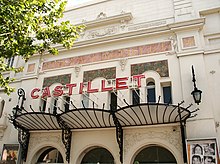Cinéma Le Castillet
The Cinéma Le Castillet is a historic cinema in Perpignan , France , and a monument of Art Nouveau .
Geographical location
The cinema is located on 1 Boulevard Wilson in Perpignan, on the ramparts of the medieval old town towards the river La Bassa .
history
The first two cinemas in Perpignan, Le Castillet and Apollo , were founded in 1911. The Apollo no longer exists, while Le Castillet is still in operation today.
Jean Font , who knew the Lumière brothers personally, founded the cinema, which has been family-owned ever since. Jean Font came from Barcelona. After a stay in Marseille or Montpellier , he discovered the later location of the Castillet cinema. After consulting his father, he returned to Perpignan and built the cinema. It was inaugurated on November 7, 1911. Local artists and critics of the building's modern architecture were invited and the opening was also dedicated to a humanitarian purpose: the proceeds went to the benefit of the relatives of the French Navy during the explosion of the battleship Liberté on September 25, 1911 in the port of Toulon 250 people had died. This dampened the vehement criticism of the establishment, which was fed by its architecture, the then prevailing racism against Spaniards and the prudery of the long 19th century in terms of new forms of entertainment.
In 1911, cinema was still limited to silent films . It therefore had its own orchestra to accompany the films. In order to cover the costs of the new building, Jean Font also organizes performances in rented rooms in towns and villages in the area.
With the beginning of the First World War in 1914, all cinemas in France were initially closed. After a short time this caused considerable financial difficulties. The then mayor of Perpignan, Denis Joseph, did not allow the house to reopen until March 6, 1915, initially under restricted conditions, including the fact that performances only take place three days a week and 25% of the profits are donated to charity had to be. It was not until December 21, 1915 that the cinema was able to resume normal operations.
In 1918 the cinema was expanded. Things went very well in the years after the war because the population wanted to distract themselves from the horrors of the war. Le Castillet offered a varied program that was regularly updated. Continuation films were shown with great success, but also small operettas or plays were performed. In 1922, Jean Font organized an open-air cinema in front of the house for the first time. At first, entry was free, which turned out to be a great success. But even the then introduced unit price of 1 franc did not affect the success.
Relations between the city administration and Jean Font remained tense. Jean Font temporarily refused to pay imposed taxes in order to keep the house open at all. On the other hand, he was also discriminated against as a Spanish citizen.
building
architecture
When Jean Font had the building erected, he commissioned Eugène Montès to design the facade with the participation of the sculptor Alexandre Guènot - as modern as the cinema was back then. The architecture of the entrance area is based on that of a theater building from the end of the 19th century. The decoration, however, is highly eclectic with strong elements of Art Nouveau. This architecture was heavily criticized by and in public. A journalist described the building as a cenotaph and "cemetery architecture ". Inside the building there were, in addition to the facilities required for the cinema, a dance hall, an ice rink and a café-bar.
Architectural significance
Facades and roofs of the building were placed under monument protection in 1997 .
In 2015, the building was placed under the Patrimoine du XXe siècle label together with Magasin Aux Dames de France .
present
Today the cinema has 8 halls with 1872 seats. It is now one of the oldest cinemas in France and probably the oldest French cinema still in operation.
literature
- Erick Cala: Histoire du cinéma Perpignan à travers la famille Font (1911–1996). Ainsi les Font font le cinéma à Perpignan . Université de Perpignan 1996. Without ISBN.
- Direction régionale des affaires culturelles du Languedoc-Roussillon: Focus Patrimoine du XXe siècle à Perpignan . Perpignan 2015. Without ISBN. [Brochure]
- NN: Les débuts du spectacle cinémathèque à Perpignan . In: Les cahiers de la cinémathèque No. 1, Cinémathèque euro-régionale. Jean Vigo Institute. January 1971, p. 35.
Web links
Individual evidence
- ^ Base Mérimée.
- ↑ Direction: Focus Patrimoine , p. 7.
- ↑ Albert Bausil in Le Cri catalan of November 11, 1911.
- ↑ Direction: Focus Patrimoine , p. 16.
- ^ Base Mérimée.
- ↑ Direction: Focus Patrimoine , p. 16.
- ^ Base Mérimée.
Coordinates: 42 ° 42 ′ 4.6 " N , 2 ° 53 ′ 40.7" E




